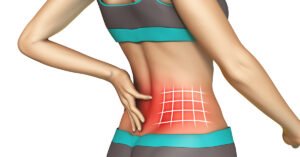Lower Backache

Lower backache, also known as lower back pain or lumbar pain, is a common musculoskeletal condition characterized by discomfort or pain in the lower region of the spine, specifically in the lumbar vertebrae.
Here’s an overview of its symptoms, causes, and treatments:
Lower backache can range from mild, occasional discomfort to severe, debilitating pain that interferes with daily activities. It can affect people of all ages and may be acute (lasting less than 12 weeks), subacute (lasting 4-12 weeks), or chronic (lasting more than 12 weeks).
Symptoms of lower backache may include:
Dull or Sharp Pain: Persistent or intermittent pain in the lower back, which may vary in intensity from dull aching to sharp or stabbing.
Stiffness: Stiffness or limited range of motion in the lower back, particularly after prolonged sitting or standing.
Muscle Spasms: Muscle spasms or tightness in the lower back, which may be exacerbated by movement or activity.
Radiating Pain: Pain that radiates from the lower back to the buttocks, thighs, or legs (sciatica), often accompanied by tingling, numbness, or weakness in the affected leg.
Difficulty Standing or Walking: Difficulty standing up straight or walking due to pain or stiffness in the lower back.
Lower backache can be caused by various factors, including:
Muscle Strain or Sprain: Overuse, improper lifting, or sudden movements can strain or sprain the muscles, ligaments, or tendons in the lower back.
Spinal Conditions: Degenerative disc disease, herniated discs, spinal stenosis, or spondylolisthesis can cause compression of nerves or structural changes in the spine leading to lower back pain.
Poor Posture: Prolonged sitting, standing, or poor body mechanics can contribute to muscle imbalances, spinal misalignment, and lower back pain.
Obesity: Excess weight or obesity can strain the lower back muscles and joints, increasing the risk of developing lower back pain.
Trauma or Injury: Accidents, falls, or trauma to the lower back can cause fractures, sprains, or other injuries leading to pain and discomfort.
Treatment options for lower backache depend on the underlying cause, severity of symptoms, and individual preferences, and may include:
Rest and Activity Modification: Avoiding activities that aggravate symptoms and gradually returning to normal activities as tolerated.
Physical Therapy: Stretching, strengthening, and core stabilization exercises to improve flexibility, muscle strength, and posture.
Pain Management: Over-the-counter or prescription medications such as nonsteroidal anti-inflammatory drugs (NSAIDs), muscle relaxants, or analgesics may be recommended to relieve pain and inflammation.
Heat or Cold Therapy: Applying heat packs or cold packs to the affected area to reduce pain and muscle spasms.
Manual Therapy: Chiropractic manipulation, massage therapy, acupuncture, or spinal manipulation may provide relief for some individuals.
Injections: Epidural steroid injections or nerve blocks may be recommended for severe or persistent pain not responding to conservative treatments.
Surgery: In rare cases, surgery may be considered for structural abnormalities or conditions causing nerve compression or spinal instability.

